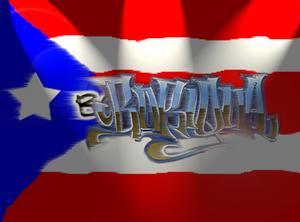Hip-Hop as a subculture
Nobody knows exactly when hip-hop was created. Elements of hip-hop have always been around. However, when the media first noticed hip-hop, it came from the streets of New York. It was widely and falsely publicized that hip-hop was a "new" black art form. What wasn't mentioned was the majority of Puerto Ricans were MCs', break dancers (Rock Steady Crew), and Graffiti artists. Some Puerto Rican artists felt that the only reason the corporate media put one type of face on hip-hop was because it made it easier for the Major Labels to market and distribute to the masses. Others also believed that the corporate media does this as a separatist move, dividing the people of the Ghettos or Barrios. As the youth in the streets came from diverse cultures and shaped hip-hop to represent the voice of the people of the streets, they eventually helped hip-hop spread across America.
The 1980s were dubbed with the Decade of the Hispanics in the media and saw an acknowledgement of the diversification and growing numbers of the Latino population. Although this phenomenon had actually begun more than a decade earlier they did not get any recognition until the 80s. Puerto Ricans made up 80 percent of the Latino population of New York in 1960; by the 1990s, this number had dropped to 50 percent. (8)
With the growing plurality of Latino groups in New York, numbers, experience and the voices began the perception of the exceptional character of Puerto Ricans with respect to other Latino groups. It also became apparent that the same factors that made Puerto Ricans a distant from other Latinos were the same one that they shared with African Americans.
Young New York Puerto Ricans have often either found themselves excluded or have excluded themselves form the generally accepted bounds of latinidad. Puerto Ricans who participate in hip hop culture have, for the most part, sought to acknowledge their own ethnic background without wholly submerging themselves under the reigning definition of latinidad or merely passing as virtual Blacks.
During the 90's, Latinos across America started putting out hip-hop albums, and many did it through independent distribution. In Northern California, Sir Dyno, Duke and the Darkroom Familia started releasing albums in their region. Soon, success and countrywide recognition were to follow. In Texas, South Park Mexican and Capone did the independent route and were able to get success. Nevertheless, in New York, The Terror Squad, Big Pun and Fat Joe took the Puerto Rican side of hip-hop to the top. Big Pun and Fat Joe helped gain renewed interest to the Major Labels into the Latino Rap Scene.
There are many artists and groups that helped drive the Latino Hip-Hop scene. While Latinos, as a whole begin spreading across the States and the world, Latinos in hip-hop will continue to grow. Today, the underground scene is as big as it has ever been. Major Labels are once again interested in Latino Artists and Groups.
Click the following links to journey through the timeline of Hip-Hop...


